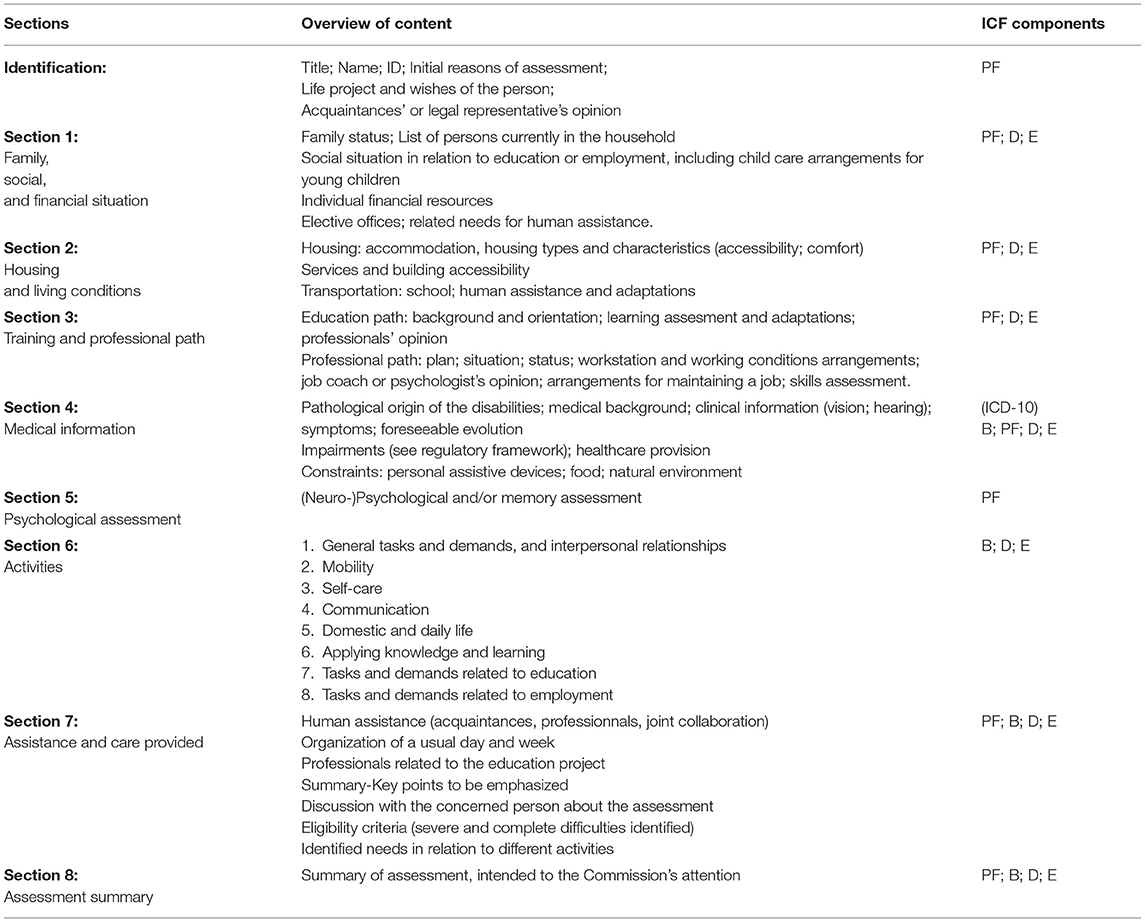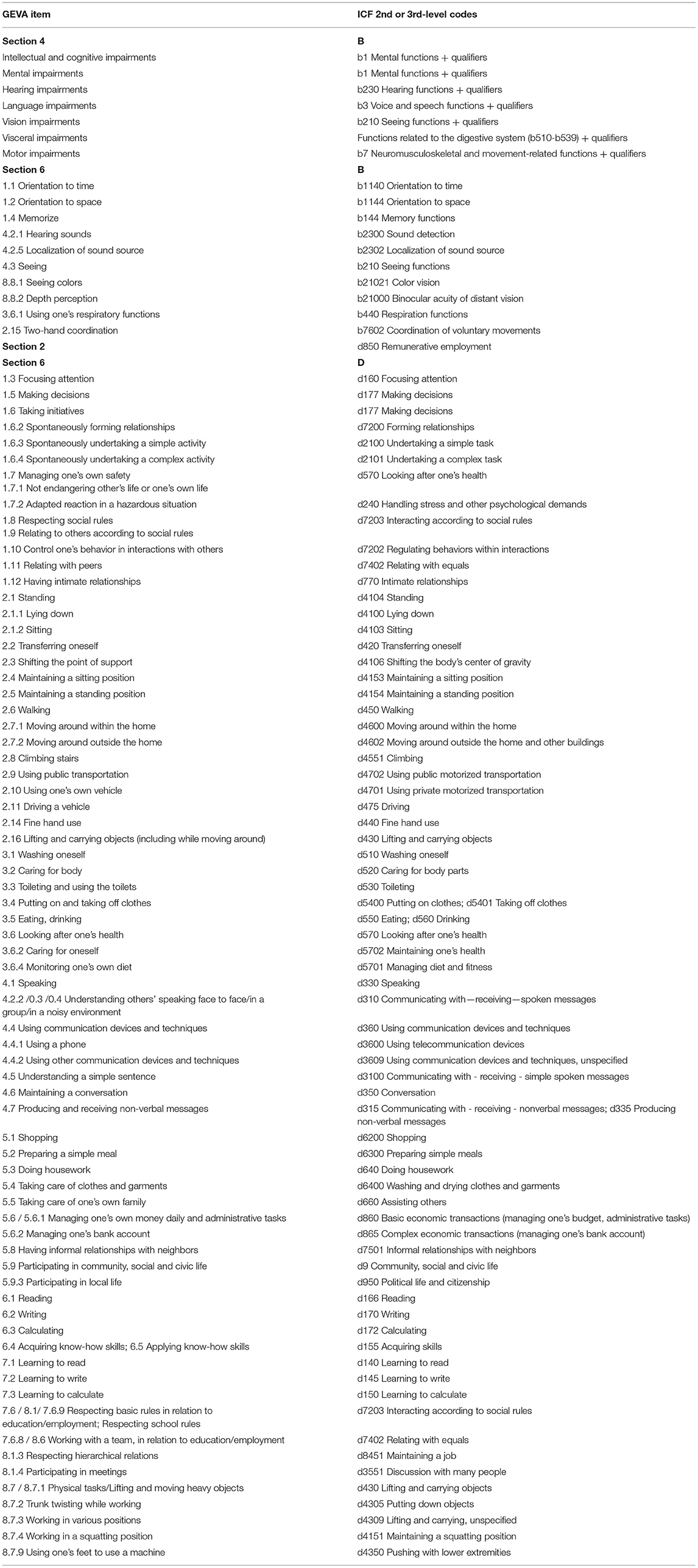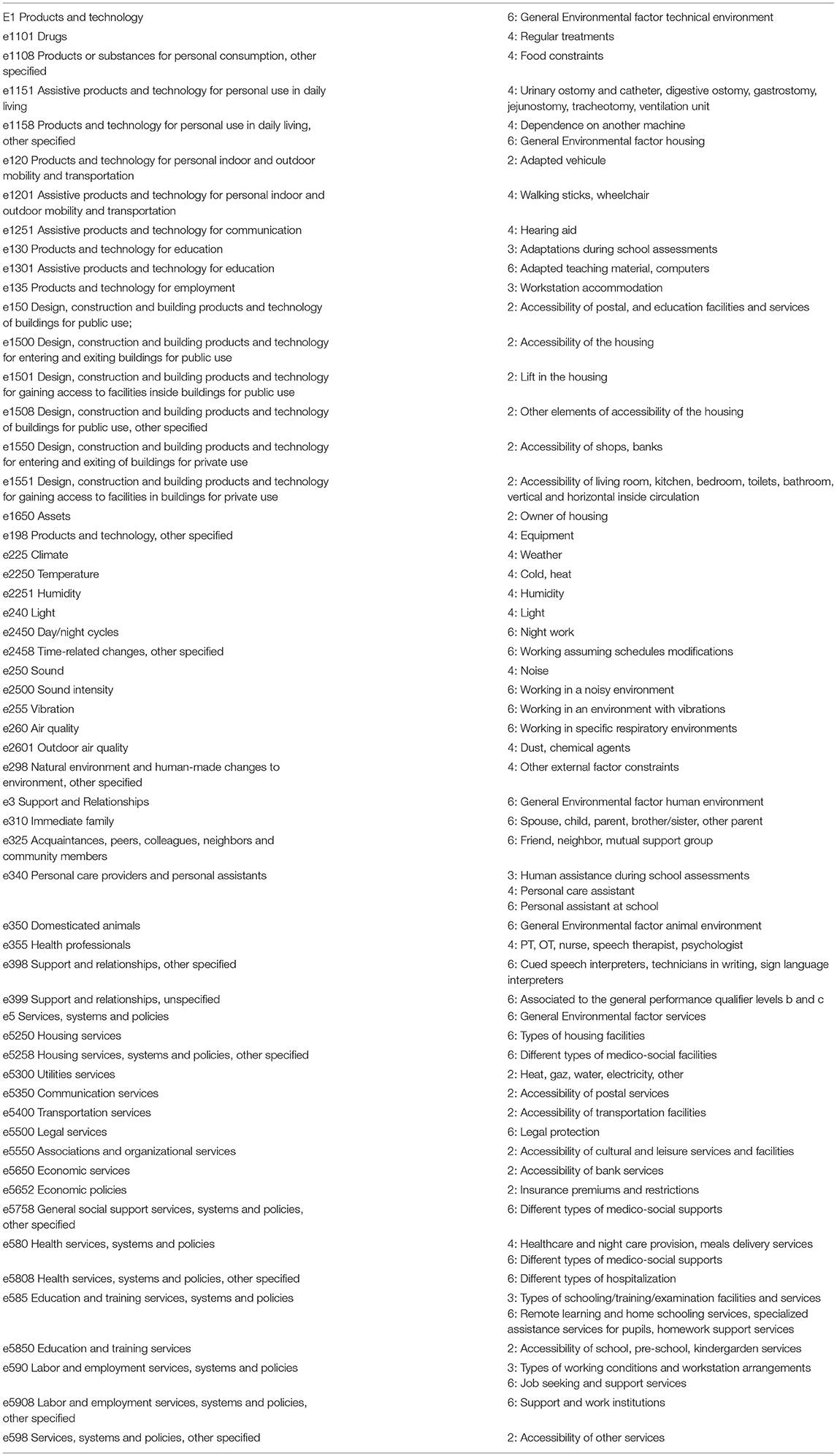- École des Hautes Etudes en Santé Publique, School of Public Health, Rennes, France
The aim of this research is two-fold. Firstly, mapping the GEVA items on to the ICF will allow identifying those items that are covered by the ICF and assist in improving the data collection process. Secondly this work will provide a first exploration of the items that are not covered by the ICF and that could lead to potential proposals for updating the ICF. The preliminary results show that the items of the GEVA 2008 general version are partly covered by the ICF 2017 Browser version categories. In every section of the GEVA, some of the items might be coded with ICF codes coming from the following ICF components: Body functions, Activities and Participation, Environmental factors, Personal factors. The items of the section 6 remains those mostly covered by the ICF. Throughout the GEVA, many environmental factors are documented. Although further analysis is needed to better inform the use of qualifiers (performance, capacity, satisfaction) together with the activities and the environmental factors, the identified ICF codes could assist in improving the data collection process. Finally, some items might be discussed to become potential ICF updates proposals.
Introduction
How should the needs of persons with disabilities be assessed so as to enable to live with optimum independence, and the means to live and participate in accordance to their wishes? In the last 50 years, France has developed a succession of laws progressively building a legal framework that aims to ensure the rights to individualized compensation measures and the rights for general accessibility to all.
The main concepts, principles, values, and rights are well-known and accepted. However, their implementation may be considered as an on-going search for improvements.
France has been involved in several international processes such as (1) the work related to the concept of disability. This includes the collaboration with WHO during the revision of the International Classification of Impairments, Disabilities, and Handicaps (1980), and the on-going maintenance of the International Classification of Functioning, Disability, and Health (ICF, WHO, 2001) and (2) the work related to the UN Convention on the rights of persons with disabilities (2006) development process. In 2010, France, together with the European Union, ratified the UN Convention.
France may broadly be described as a welfare state, and accordingly the provision for persons with disabilities needs is based on the recognition of an administrative status, namely “persons with disabilities.” The administrative system is complex and depends on the origin of the impairments or disabilities (work, health, army, life accident, etc.), and different allowances may be granted.
The 2005-102 Law “For equal rights and opportunities, participation and citizenship of persons with disabilities” has provided a new framework focusing on the right for compensation and accessibility. Firstly, this law gives a definition of disability as: “any limitation to activity or restriction to participation to life in society, that one may undergo in one's environment, due to substantial, long-term or permanent alteration of one or more physical, sensory, mental or cognitive functions, severe multiple and profound disabilities or a disabling health condition.” Although this definition does contain the concepts found in the ICF, as underlined by the UN Special Rapporteur on the rights of persons with disabilities (1): “[…] the definition of disability […] focuses on the impairment, instead of a person's interaction with the environment and existing barriers, and should therefore be revised.” Hence, the implementation of the concepts might be improved.
Nevertheless, this law has led to the set-up of, in each of the 102 French administrative territorial entities, a one-stop counter [Maison Départementale des Personnes Handicapées (MDPH)] that manages the granting of several different disability benefits, one of which being the Prestation de compensation du handicap “PCH” for citizens aged under 60 years. The MDPHs are in charge of assessing the situations and needs for the compensatory support of persons with disabilities. Each is composed of two bodies: (1) a multidisciplinary team (medical doctors, occupational therapists, psychologists, social workers, etc.) in charge of the assessment of the needs; (2) an executive board, the “Commission for the rights and independence of persons with disabilities,” composed of professionals as well as the representatives of organizations of persons with disabilities. These commissions make all decisions related to the provision of financial, technical, and human aid based on the multidisciplinary assessment, related to the development of a personalized compensation plan. The network of local authorities is supported by a national central authority (national fund of solidarity for autonomy—Caisse Nationale de Solidarité pour l'Autonomie (2) in charge of the implementation of a disability policy throughout the country.
In 2008, a national decree (2008-110, February 6, 2008) provided a guide “Guide d'évaluation multidimensionnelle” (GEVA), for the multidimensional assessment of the needs of persons with disabilities. The aim is to ensure, to the greatest extent possible, equality in the treatment of requests of individuals, equity in granting benefits, and a harmonized countrywide assessment of the situation of persons with disabilities in drawing up individualized support plans. It allows the gathering of information about the situation of an individual, summarizes the main key points of the assessment, and supports the decision process. Section 6 of GEVA aiming at supporting the decision taken to allocate the PCH has been explicitly built based on ICF categories and qualifiers.
The general version of this guide, 40 pages, has been developed in 2008 (2) and was first designed to assess the needs of adults aged under 60 years. Several complementary versions do exist, especially some focusing on education and children. As mentioned in a 2014 national study, “Generally speaking, the GEVA is used as a reference framework, but many MDPH have adapted it making their own and simplified versions. Professionals involved in assessment use the sections that seem most relevant and useful to them in relation to the situation. […] A majority of the MDPH use a tool for gathering information at the individual's home. Half of these tools are ad-hoc tools that contain GEVA items” [(3), p. 36, Translation M. Cuenot].
This initial version provided to the professionals contains no codes and no formal procedure designed to be used for data collection. Only in the annex of the 2008 decree, some hierarchical ad hoc codes are provided for each item and each possible response. The hierarchy is organized by the order of GEVA sections.
The aim of this research is two-fold. Firstly, mapping of the GEVA items onto the ICF will allow to identify those items that are covered by the ICF and assist in improving the data collection process. Secondly, this work will provide the first exploration of the items that are not covered by the ICF, and then could lead to potential additional proposals for updating the ICF. After introducing the method used for this mapping, some preliminary results will be described and then discussed.
Methods
The items of the general 2008 paper-based version of the GEVA have been used as a reference version for this mapping (2). They have been translated into English by the author of this paper. Table 1 gives an overview of the content divided up into eight sections. Our analysis did not only take into account the GEVA Section 6 explicitly related to Activities, but also the GEVA Sections 1–5, the Sections 7 and 8 being merely the summaries of the other sections. We hypothesized that some other sections could also be coded with the ICF.
The linking rules formulated by Cieza et al. (4, 5) have guided the mapping work. The ICF 2017 browser version, currently available online, has been used as the reference ICF version for this work. In a general statistic approach, every different GEVA item has been counted in Sections 1–6, thus not including duplicated ones and counting only one ICF category for one GEVA item. The main results presented here are based on a qualitative analysis of the content of the GEVA for the aim is rather showing which ICF categories may be used to code the GEVA items than showing how many GEVA items are coded (several GEVA items may correspond to one same ICF category or are duplicated several times throughout the GEVA).
Results
Preliminary results show that the GEVA items are partly covered by the ICF. The general statistic approach allows to estimate that 80% (343 of 435) of the GEVA items can be covered by the ICF categories. In each of the six considered sections of the GEVA, some of the items may be coded with the ICF codes. Hence, not only the items of the Section 6 of the GEVA explicitly relate to Activities but also some items of the other GEVA Sections 1–5 belong to the universe of the ICF. The covered items are related to the following ICF components: Body functions (B), Activities and Participation (D), Environmental factors (E), and Personal factors (PF).
Some items are covered by other international classifications. In Section 4, the information related to diseases and rare diseases and to hearing and vision could be coded with ICD-10 codes. Some items may also be covered by the 1980 ICIDH categories. Indeed, some parts of the national regulatory framework still use impairments and disabilities to specifically fix the disability rates (Guide-barème). These impairment-related items may be mapped onto some ICF B categories and a related qualifier (Table 2).
The section in which the GEVA items are mostly covered by the ICF D chapters remains Section 6 (Table 2). Each item of this section is explicitly intended to be assessed through the two qualifiers: functional capacity and performance. Functional capacity should be assessed with the following scale, which is similar to the one recommended for the ICF: “0”: No difficulty; “1”: Mild difficulty; “2”: Moderate difficulty; “3”: Severe difficulty; “4”: Total difficulty; and “9”: Non-applicable. Performance should be assessed with another scale: a-activity performed alone; b-activity partially performed with human assistance; c-activity performed with continued assistance; and d-activity not performed.
This performance scale provides the information about the environment, especially mentioning the potential impact of human assistance on the performed activity. This means that conceptually the data that might be collected at that stage should contain one related to D and one related to E. The following general five types of E are required to be documented as facilitators or barriers during the performance assessment: human environment [ICF chapter e3 Support and relationships]; technical assistance [e1 Products and technology] housing adaptations [e1158 Products and technology for personal use in daily living, other specified]; services [e5 Services, systems, and policies]; and animal assistance [e350 Domesticated animals]. Additionally, in this GEVA Section 6, a list of items are given for a more in-depth assessment of the human, technical, and animal assistance provided in each life domain. A related satisfaction assessment scale is eventually included to collect the point of view of the individual about the situation: complete satisfaction; satisfaction; mild satisfaction; and no satisfaction.
Hence, throughout the GEVA sections, many E are listed that may be documented. Table 3 presents the corresponding ICF E categories that are covered. Some require additional information to know whether they have an impact on the individual situation, as a facilitator or an obstacle. Others only require to be identified as being provided or not. A more in-depth analysis would allow more information on how they are formulated in relation to the ICF E qualifiers. Nevertheless, these preliminary results show that the ICF E Chapters 1, 2, 3, and 5 are documented throughout the GEVA items. The categories of Chapter 4 related to Attitudes are not represented as such.
Throughout the GEVA, some items are also related to PF. Some additional qualitative information is listed in the GEVA and relates to proxy and points of view of professionals about the situation of an individual (psychological, medical, educational, apprenticeship, and professional).
Finally, some GEVA items might be covered by the ICF but no exact match is really possible. Table 4 presents them together with the potentially lacking concept. They are mainly related to D and E. Other GEVA items cannot at all be coded with the ICF for they require qualitative information, either the point of view of other persons in relation to the main one asking for an assessment, or administrative information about some applications in progress and time-related information. The satisfaction qualifier is also not a part of the ICF.
Discussion
These preliminary results of this GEVA-ICF mapping provides a first overview of the ICF coverage potential. The categories stemming from the D chapters and the Environmental chapters, together with the corresponding qualifiers, are well-represented. Not completely covered items deal in particular with education and employment (see Table 4). They raise some issues on how to better implement specific adaptations in these two areas and others so as to facilitate the coding and collection of some precise information.
This also underlines the needs to better document the way of interaction of these components together in some specific areas, in particular such as education or employment, which are the two major areas in the individual life project.
In the ICF education category (d820), additional information could then be added in relation to assessment/examination criteria, organizing and checking one's own work, getting organized in the classroom, getting used to school life, using learning (adapted) materials, taking notes, and participating in after-school activities. Several GEVA items also relate to the learning process: learning how to use communication techniques, or basic social rules, asking for help or assistance.
In the employment area, additional information could be added about organizing and checking one's work, working at height, working with the dominant/non-dominant arm, and working in hazardous environments.
Furthermore, the GEVA satisfaction qualifier is currently used and allows a better understanding of the impact of the E. A more in-depth analysis is needed to firstly better inform the use of qualifiers together with E and secondly to improve the identification of the items directly covered by the ICF definition of PF and others that might not be covered but which provided relevant information for a better understanding of the situation and project of an individual.
In relation to E and PF, there is also a need to distinguish on one hand the content directly inspired by the French regulatory framework and on the other hand the content based on the ICF concepts and implementation rules. The GEVA has been designed in accordance with the French legal framework and not its whole content may be applied to other social and cultural contexts without adaptation.
The GEVA items not completely covered by the ICF might benefit from the discussions with other ICF experts so as to better evaluate them as potential ICF update proposals.
Conclusion
This mapping approach shows that firstly the items of the GEVA 2008 general version are partly covered by the ICF 2017 Browser version categories. In every section of the GEVA, some of the items might be coded with the ICF codes obtained from the following ICF components: B, D, E, and PF. The items of Section 6 remains those mostly covered by the ICF. Throughout the GEVA, many E factors are documented. Although further analysis is needed to better inform the use of qualifiers (performance, capacity, and satisfaction) together with the D, and the E, the identified ICF codes could assist in improving the data collection process. Finally, some items might be discussed to become potential ICF update proposals.
Data Availability Statement
The raw data supporting the conclusions of this article will be made available by the authors, without undue reservation.
Author Contributions
The author confirms being the sole contributor of this work and has approved it for publication.
Conflict of Interest
The author declares that the research was conducted in the absence of any commercial or financial relationships that could be construed as a potential conflict of interest.
Publisher's Note
All claims expressed in this article are solely those of the authors and do not necessarily represent those of their affiliated organizations, or those of the publisher, the editors and the reviewers. Any product that may be evaluated in this article, or claim that may be made by its manufacturer, is not guaranteed or endorsed by the publisher.
Acknowledgments
The author would like to thank William Sherlaw for reading the first draft in English.
References
1. Human Rights Council. Visit to France. Report of the Special Rapporteur on the Rights of Persons With Disabilities. United Nations General Assembly (2019).
2. Caisse nationale de solidarité pour l'autonomie (CNSA). GEVA – Guide d'évaluation multidimensionnelle. (2008). Available online at: https://www.cnsa.fr/documentation/geva_graphique-080529-2.pdf
3. Ministère des affaires sociales et de la santé Haut conseil de la santé publique Cekoïa Conseil. Enquête quantitative sur les modes d'évaluation et de traitement des demandes de compensation du handicap par les MDPH, Rapport final. (2014). Available online at: https://www.google.com/url?sa=t&rct=j&q=&esrc=s&source=web&cd=&ved=2ahUKEwi1oMHi46rwAhXHDGMBHZTfA2wQFjABegQIBhAD&url=https%3A%2F%2Fwww.hcsp.fr%2FExplore.cgi%2FTelecharger%3FNomFichier%3Dhcspr20150511_evalbesoinhandicapmdph.pdf&usg=AOvVaw2WklIiwguHt7e3benEF0x9
4. Cieza A, Fayed N, Bickenbach J, Prodinger B. Refinements of the ICF linking rules to strengthen their potential for establishing comparability of health information. Disabil Rehabil. (2019) 41:574–83. doi: 10.3109/09638288.2016.1145258
Keywords: ICF, assessment, mapping, France, GEVA disability assessment tool
Citation: Cuenot M (2021) Mapping of the GEVA Items to the ICF: Preliminary Results Based on the Content of a Tool Guide Used to Assess the Needs of Persons With Disabilities in France. Front. Rehabilit. Sci. 2:721685. doi: 10.3389/fresc.2021.721685
Received: 07 June 2021; Accepted: 13 August 2021;
Published: 14 September 2021.
Edited by:
Michaela Coenen, Pettenkofer School of Public Health, GermanyReviewed by:
Patricia Welch Saleeby, Bradley University, United StatesOlaf Kraus De Camargo, McMaster University, Canada
Copyright © 2021 Cuenot. This is an open-access article distributed under the terms of the Creative Commons Attribution License (CC BY). The use, distribution or reproduction in other forums is permitted, provided the original author(s) and the copyright owner(s) are credited and that the original publication in this journal is cited, in accordance with accepted academic practice. No use, distribution or reproduction is permitted which does not comply with these terms.
*Correspondence: Marie Cuenot, bWFyaWUuY3Vlbm90QGVoZXNwLmZy
 Marie Cuenot
Marie Cuenot


